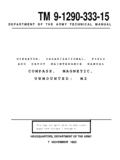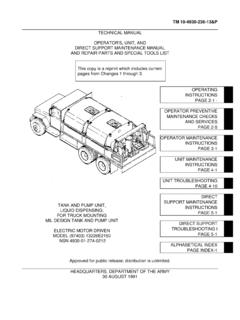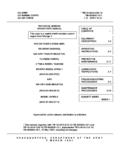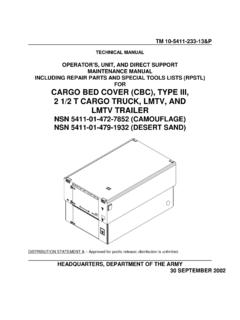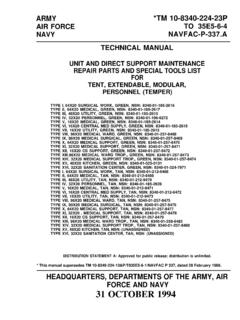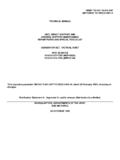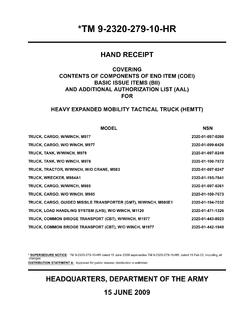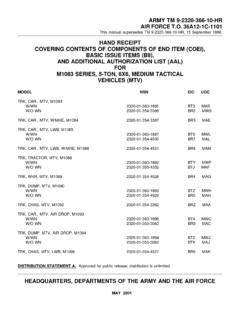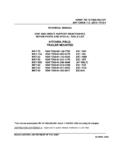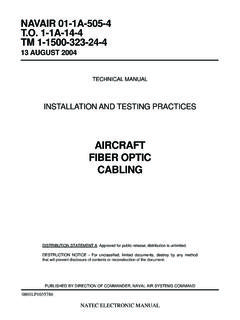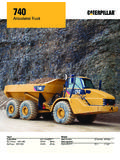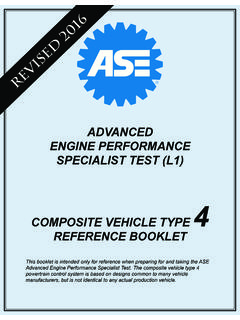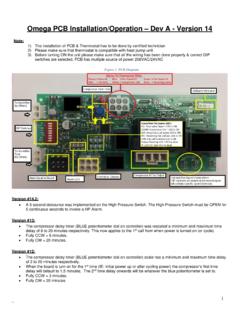Transcription of TM 11-5820-890-10-1 - Liberated Manuals.com
1 TM 11-5820-890-10-1 . TECHNICAL MANUAL. OPERATOR'S MANUAL. SINCGARS GROUND. COMBAT NET RADIO, ICOM. MANPACK RADIO. AN/PRC-119A (NSN 5820 -01-267-9482) (EIC: L2Q). SHORT RANGE VEHICULAR RADIO. AN/VRC-87A (NSN 5820 -01-267-9480) (EIC: L22). SHORT RANGE VEHICULAR RADIO. WITH SINGLE RADIO MOUNT. AN/VRC-87C (NSN 5820 -01-304-2045) (EIC: GDC). SHORT RANGE VEHICULAR RADIO. WITH DISMOUNT. AN/VRC-88A (NSN 5820 -01-267-9481) (EIC: L23). SHORT RANGE VEHICULAR RADIO. WITH DISMOUNT AND SINGLE RADIO MOUNT. AN/VRC-88C (NSN 5820 -01-304-2044) (EIC: GDD). SHORT RANGE/LONG RANGE VEHICULAR RADIO. AN/VRC-89A (NSN 5820 -01-267-9479) (EIC: L24). LONG RANGE VEHICULAR RADIO. AN/VRC-90A (NSN 5820 -01-268-5105) (EIC: L25). SHORT RANGE/LONG RANGE VEHICULAR RADIO. WITH DISMOUNT. AN/VRC-91A (NSN 5820 -01-267-9478) (EIC: L26). LONG RANGE/LONG RANGE VEHICULAR RADIO. AN/VRC-92A (NSN 5820 -01-267-9477) (EIC: L27). Approved for public release; distribution is unlimited. HEADQUARTERS, DEPARTMENT OF THE ARMY.
2 1 SEPTEMBER 1992. TM 11-5820-890-10-1 . ELECTRICAL SHOCK. SAFETY STEPS. DO NOT TRY TO PULL OR GRAB THE INDIVIDUAL. IF YOU CANNOT TURN OFF THE ELECTRICAL POWER, PULL, PUSH, OR LIFT THE PERSON TO SAFETY USING A DRY WOODEN POLE OR A. DRY ROPE OR SOME OTHER INSULATING MATERIAL. SEND FOR HELP AS SOON AS POSSIBLE. AFTER THE INJURED PERSON IS FREE OF CONTACT WITH THE SOURCE. OF ELECTRICAL SHOCK, MOVE THE PERSON A SHORT DISTANCE AWAY. AND IMMEDIATELY START ARTIFICIAL RESUSCITATION. FOR ARTIFICIAL RESPIRATION, REFER TO FM 21-11. WARNING. RF ENERGY IS PRESENT NEAR THE ANTENNA DURING TRANSMISSION. MAINTAIN. AT LEAST 30 INCHES BETWEEN VEHICULAR ANTENNA AND PERSONNEL DURING. TRANSMISSIONS. WARNING. HIGH VOLTAGE. EXISTS AT CONNECTOR J1 ON VEHICULAR. MOUNTING ADAPTER. AVOID PERSONAL IN- JURY: BE SURE J1 IS COVERED OR CAPPED. WHEN NOT IN USE. DEATH OR SERIOUS INJURY CAN RESULT: When antenna tip caps are not installed on antennas. When a tied-down antenna hits a fixed object such as an overhead bridge, tree limb, etc.
3 Flying antenna parts might strike nearby personnel. A. TM 11-5820-890-10-1 . WARNING. A lithium battery used with your manpack radio contains pressurized sulfur dioxide gas. The gas is toxic, and the battery MUST NOT be abused in any way which may cause the battery to rupture. DC NOT heat, short circuit, crush, puncture, mutilate, or disassemble bat- teries. DO NOT USE any battery which shows signs of damage, such as bulging, swelling, disfigurement, a brown liquid in the plastic wrap, a swollen plastic wrap, etc. DO NOT test lithium batteries for capacity. DO NOT recharge lithium batteries. DO NOT dispose of lithium batteries with ordinary trash/refuse. Turn in dis- charged batteries to local supply. If the battery compartment becomes hot to the touch, if you hear hissing or burping ( , battery venting), or smell irritating gas (sulfur dioxide), IMMEDIATELY TURN OFF the equipment and leave the area. 1. Allow the equipment to cool at least one hour. 2. Remove and replace battery after the equipment has cooled to the touch.
4 3. If there is a safety incident, or if you believe a safety hazard exists, notify your local Safety Office/Officer, file a Product Quality Deficiency Report, SF Form 368, and notify the CECOM Safety Office, Ft. Monmouth, NJ at AV 995-3112. DO NOT use a Halon type fire extinguisher on a lithium battery fire. In the event of a fire near a lithium battery(ies), rapid cooling of the lithium battery(ies) is important. Flood the equipment with water, or use a carbon dioxide (CO2) extinguisher. Control of the equipment fire, and cooling, may prevent the battery from venting and potentially exposing lithium metal. In the event that lithium metal becomes involved in fire, the use of a graphite based Class D fire extinguisher is recommended. DO NOT store batteries in unused equipment. DC NOT store lithium batteries with other hazardous materials. Keep them away from open flame or heat. B. *TM 11-5820-890-10-1 . TECHNICAL MANUAL HEADQUARTERS. DEPARTMENT OF THE ARMY. No. 11-5820-890-10-1 Washington, DC, 1 September 1992.
5 OPERATOR'S MANUAL. RADIO SETS. MANPACK (MP). AN/PRC-119A (NSN 5820 -01-267-9482) (EIC: L2Q). SHORT RANGE VEHICULAR RADIO (SR). AN/VRC-87A (NSN 5820 -01-267-9480) (EIC: L22). SHORT RANGE VEHICULAR RADIO. WITH SINGLE MOUNT (SR). AN/VRC-87C (NSN 5820 -01-304-2045) (EIC: GDC). SHORT RANGE VEHICULAR RADIO. WITH DISMOUNT (SR-D). AN/VRC-88A (NSN 5820 -01-267-9481) (EIC: L23). SHORT RANGE VEHICULAR RADIO. WITH DISMOUNT AND SINGLE MOUNT (SR-D). AN/VRC-88C (NSN 5820 -01-304-2044) (EIC: GDD). SHORT RANGE/LONG RANGE VEHICULAR RADIO (SR/LR). AN/VRC-89A (NSN 5820 -01-267-9479) (EIC: L24). LONG RANGE VEHICULAR RADIO (LR). AN/VRC-90A (NSN 5820 -01-268-5105) (EIC: L25). SHORT RANGE/LONG RANGE VEHICULAR RADIO. WITH DISMOUNT (SR/LR-D). AN/VRC-91A (NSN 5820 -01-267-9478) (EIC: L26). LONG RANGE/LONG RANGE VEHICULAR RADIO (LR/LR). AN/VRC-92A (NSN 5820 -01-267-9477) (EIC: L27). l This manual supersedes TM 11-5820-890-10-1 , dated 1 March 1988. i TM 11-5820-890-10-1 . TABLE OF CONTENTS. PAGE. HOW TO USE YOUR MANUAL.
6 Vii CHAPTER 1 INTRODUCTION .. 1-1. Scope .. 1-1. Section I General Information .. 1-2. Maintenance Forms, Records and Reports .. 1-2. Consolidated Index of Army Publications and Blank Forms 1-2. Reporting Equipment Improvement Recommendations .. 1-3. Reporting Errors and Recommending Improvements .. 1-3. Hand Receipt (-HR) Manuals .. 1-3. Security Classification and Marking .. 1-3. II Equipment Description .. 1-4. Capabilities and Features .. 1-4. Characteristics .. 1-4. Differences Between Models .. 1-5. Equipment Data .. 1-5. Performance .. 1-6. Location and Description of Major Components .. 1-7. Major Components Used With Radio Sets .. 1-14. III Technical Principles of Operation .. 1-15. Scope .. 1-15. General Description .. 1-15. Functional Description .. 1-15. CHAPTER 2 OPERATOR'S INSTRUCTIONS .. 2-1. Scope .. 2-1. Section I Description and Use of Operator's Controls, Indicators, and Connectors .. 2-1. Receiver-Transmitter .. 2-2. Loudspeaker-Control Unit LS-671/U.
7 2-11. ECCM Fill Device .. 2-12. Mounting Adapter .. 2-13. Power Amplifier Mount .. 2-14. Power Supply Adapter .. 2-15. II ASSEMBLY AND PREPARATION FOR USE .. 2-16. Scope .. 2-16. Manpack Radio Assembly .. 2-16. installation of Primary Battery and Battery Box .. 2-16. Antenna .. 2-18. Handset .. 2-19. Field Pack .. 2-19. Vehicular Radio Assembly .. 2-20. ii TM 11-5820-890-10-1 . Dismounting RT .. 2-20. Mounting RT .. 2-23. Cabling .. 2-24. Antenna .. 2-28. Checking and Setting Life Condition of Lithium Battery .. 2-30. Removing and Changing Hold Up Battery (HUB) .. 2-32. Pre-mission Check .. 2-32. Ill Single Channel Operating Procedures .. 2-33. Loading Frequencies .. 2-33. Clearing Frequencies .. 2-34. Loading Offset Frequencies .. 2-34. Clearing Offset Frequencies .. 2-34. IV Frequency Hopping Operating Procedures .. 2-35. Scope .. 2-35. Loading FH Data (local fill) .. 2-35. Clearing FH Data (local fill) .. 2-37. Loading COMSEC Keys (local fill) .. 2-38. Basic COMSEC Procedures.
8 2-39. Pre-mission Check .. 2-40. Net Opening .. 2-41. Cold Start Net Opening .. 2-41. FH Update Using ERF .. 2-44. CUE .. 2-45. Late Net Entry .. 2-45. Passive .. 2-45. CUE and ERF .. 2-46. Jamming and Antijamming .. 2-47. V Operator Troubleshooting Procedures .. 2-51. CHAPTER 3 NCS PROCEDURES .. 3-1. Scope .. 3-1. Section I Complete Net Opening Procedures and ERF .. 3-1. Introduction .. 3-1. Local Fills .. 3-3. Lockout Set .. 3-3. Hopset .. 3-4. Cold Start Transmission Security Key (TSK) .. 3-5. Checking and Setting FH Sync Time .. 3-5. NCS Notes .. 3-8. Summary of Cold Start Net Opening Procedure .. 3-9. iii TM 11-5820-890-10-1 . TABLE OF CONTENTS Continued Cold Start Net Opening .. 3-10. II Additional NCS Procedures .. 3-13. FH Update Using ERF .. 3-13. Bringing Another Station Into the Net .. 3-14. Changing Hopset Identification (ID) .. 3-15. Monitoring FH Sync Time of Other Nets .. 3-16. COMSEC Key Loading (Remote Fill) .. 3-16. Jamming and Antijamming .. 3-18.
9 Ill NCS Troubleshooting Procedures .. 3-19. CHAPTER 4 OTHER OPERATING PROCEDURES .. 4 - 1. Scope .. 4-1. Section I Control, Receiver-Transmitter (RCU) C-11561 (C)/U .. 4-1. Introduction .. 4-1. Operator's Controls, Indicators, and Connectors .. 4-2. Operation .. 4-3. Operational Notes .. 4-3. Intercom (ICM) Operation .. 4-4. Self-Test .. 4-4. Cabling .. 4-5. II Control-Monitor (CM) .. 4-9. Operator's Controls, Indicators, and Connectors .. 4-9. Initial Set-Up and Self-Test .. 4-10. Setting and Changing RT Functions .. 4-11. Cabling .. 4-12. III ECCM Fill Device .. 4-13. Checking for Fill Data in Fill Device .. 4-13. Zeroing Fill Device Data .. 4-13. Loading Fill Device Using Another Fill Device .. 4-14. IV Operation with External Equipment .. 4-15. Checking/Setting Data Rate .. 4-15. Operation with External Equipment .. 4-16. Interconnecting Cabling Diagrams .. 4-16. VIC .. 4-18. Main Junction Box .. 4-19. Control Box .. 4-19. Wire Line Adapter .. 4-20. iv TM 11-5820-890-10-1 .
10 V Additional Operating Procedures .. 4-21. Retransmit .. 4-21. SC to SC .. 4-21. FH to FH .. 4-22. SC to FH .. 4-22. ERF Relay .. 4-23. Operational Notes .. 4-24. Scanning .. 4-25. Battery Tray .. 4-26. Mounting Battery Box on Battery Tray .. 4-26. Checking Battery Life Condition .. 4-26. Section VI Operation Under Unusual Conditions .. 4-27. Emergency Procedures .. 4-27. Unusual Weather .. 4-30. Fording .. 4-30. CHAPTER 5 MAINTENANCE INSTRUCTIONS .. 5-1. Scope .. 5-1. Section I PMCS .. 5-1. Battery Physical Condition .. 5-3. Battery Electrical Condition .. 5-3. Hold Up Battery (HUB) Electrical Condition .. 5-3. Receiver-Transmitter Self-Test .. 5-4. Transmitter .. 5-5. Mounting Adapter and Mounting Base (or power supply adapter and single radio mount) .. 5-5. Remote Operation .. 5-6. Control-Monitor Self-Test .. 5-6. Control-Monitor RT Function Control .. 5-7. Cables .. 5-8. Section II Troubleshooting Procedures .. 5-9. Radio .. 5-11. Power Source .. 5-11. Self-test.
